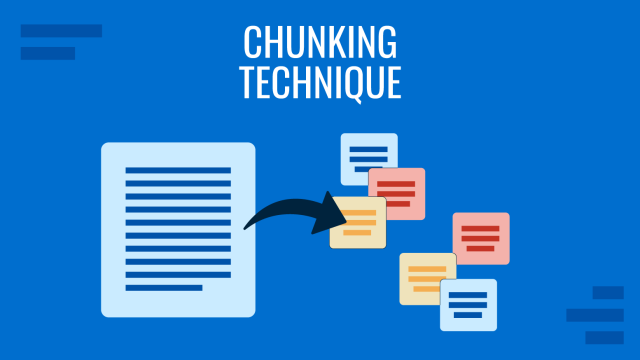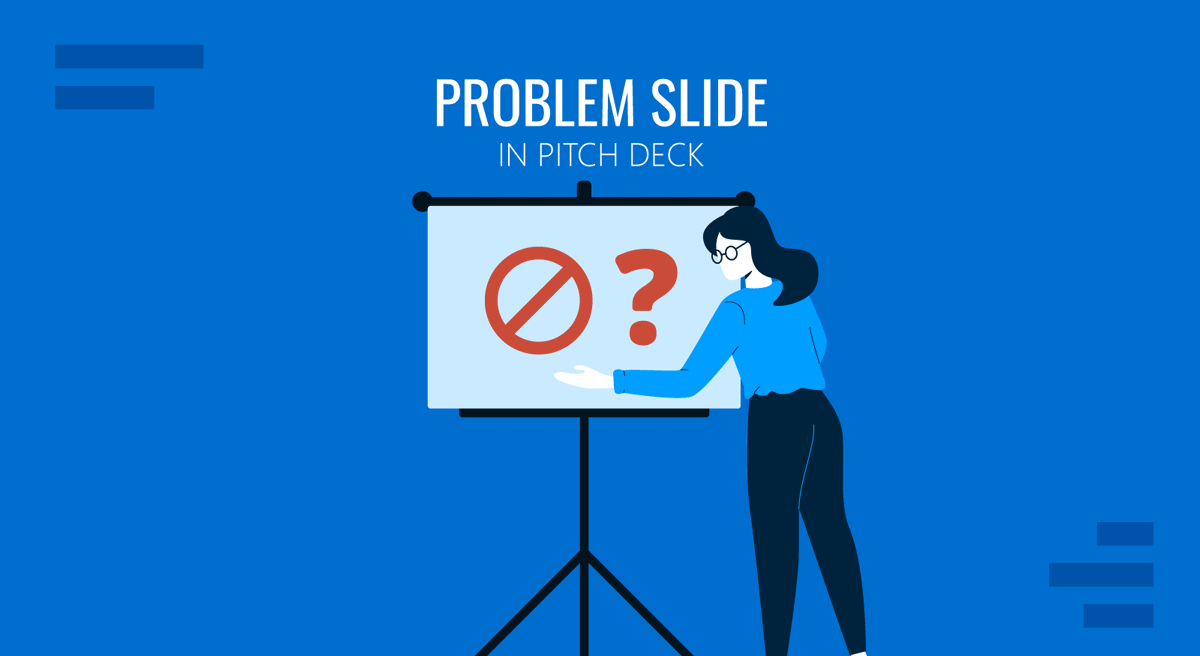
The problem slide sets the stage for the entire pitch. It defines the tension that gives the startup’s existence meaning. Every investor, even before hearing your solution, wants to understand what gap you’ve identified and why it matters. It’s not about dramatizing issues; it’s about clarity and precision. It tells the story of a pain point so real that ignoring it feels irrational.
When delivered well, the problem slide transforms your presentation from an abstract idea into a grounded business opportunity. It’s not a complaint list or a sympathy plea. It’s a structured explanation of an inefficiency, an unmet need, or a behavioral shift that the market has not yet addressed. The audience must walk away understanding the scope and urgency of the issue without you ever having to oversell it.
In this article, we’ll learn how to structure a problem slide for an investor pitch deck. Which visuals make it stand out, how to frame the problem, as well as connecting the problem to the target audience.
Table of Contents
- Why the Problem Slide Matters in Investor Communication
- Framing the Problem: How to Present It Effectively
- Building Credibility Through Data and Context
- Connecting the Problem to the Target Audience
- What to Include in a Problem Slide
- PowerPoint Templates for the Problem Slide
- Mistakes to Avoid When Building the Problem Slide
- FAQs
- Final Words
Why the Problem Slide Matters in Investor Communication
Investors are pattern recognizers. They’ve seen hundreds of solutions, but what they really fund is the quality of the problem. A well-framed problem demonstrates strategic maturity; it proves that the founders understand where disruption can create value.
A good problem slide reduces perceived risk. When investors recognize a clear, validated pain point, they can mentally map the size of the opportunity. The more specific and measurable the problem, the easier it is for them to visualize market traction. For instance, “90% of small retailers in Latin America still rely on pen-and-paper inventory management” communicates both scale and urgency.
From a visual communication standpoint, the problem slide also sets the rhythm of emotional engagement. It invites empathy before you introduce logic. Audiences must feel the friction before you present the fix. This emotional anchor helps investors remember your story when they review dozens of decks in a single week.
Another reason the slide matters is alignment. By articulating the problem correctly, you ensure that the audience’s expectations align with what your startup truly solves. Founders who misframe the issue risk appearing disconnected from the market. A clear, data-supported problem statement tells investors, “We know the battlefield. We’ve lived this pain. We know what others are missing.”
Finally, this slide supports credibility through focus. It shows that your company is solving one specific issue, not everything at once. This perceived discipline in problem selection reflects strategic restraint, something investors appreciate in early-stage teams.
Framing the Problem: How to Present It Effectively
The problem slide should present a market tension that feels both undeniable and solvable. The language should be objective, not emotional. You’re not complaining; you’re analyzing. The goal is to describe an inefficiency so concrete that its existence alone validates the need for a new approach.
Start by describing the current reality. How do users, industries, or systems operate today, and where are the cracks? If possible, narrate a short real-world scenario that encapsulates the issue. For example, “A freelance designer spends an average of six hours per week sending invoices manually because no invoicing software fully integrates with their local tax system.” This kind of statement instantly grounds the problem in behavior and cost.
Recommended lecture: Data Storytelling for Presentations
Next, illustrate why the problem persists. Investors are not impressed by temporary inconveniences; they’re interested in structural pain. Explain whether the friction stems from outdated infrastructure, lack of digital literacy, policy barriers, or inefficient incumbents. This layer of explanation shows that you’ve investigated root causes.
A third aspect is impact. Quantify the cost of inaction. Numbers make problems real: lost revenue, wasted time, compliance risks, or customer dissatisfaction. Whenever possible, connect data to emotion; people remember how big problems feel when attached to measurable outcomes.
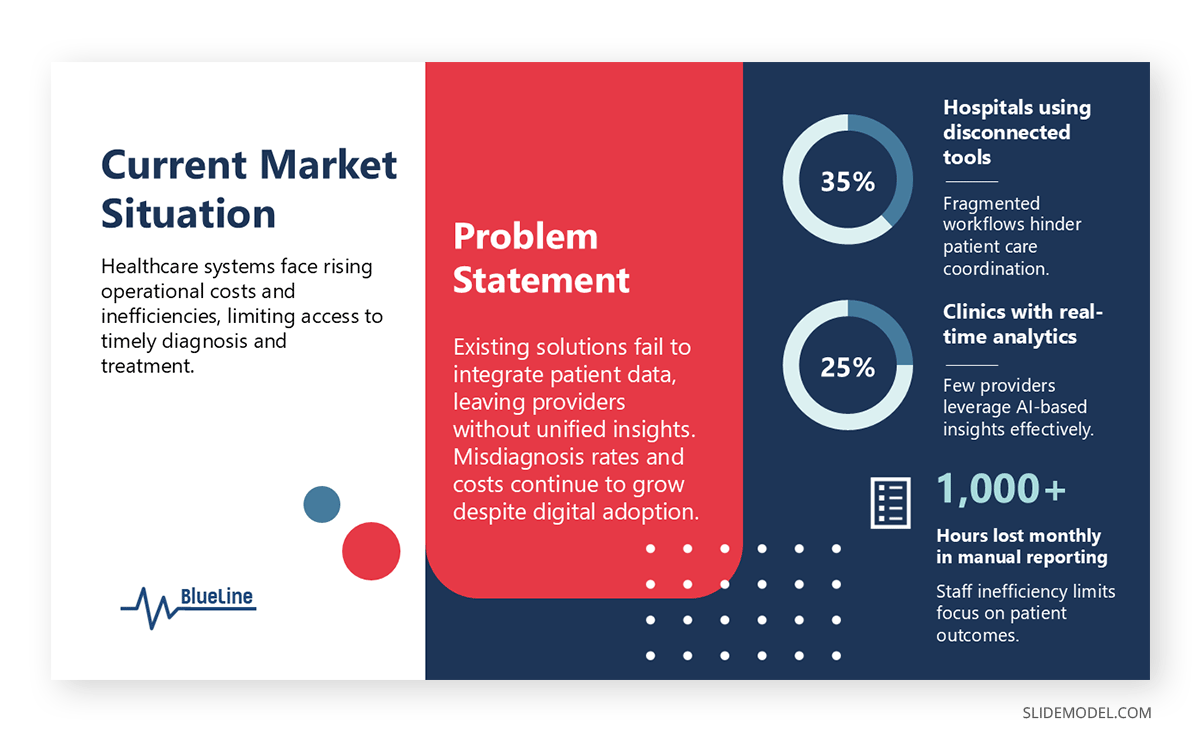
Finally, ensure the problem has a defined audience. Avoid vague universality. Statements like “everyone struggles with this” weaken your position. Instead, narrow your claim: “Mid-size logistics companies in Southeast Asia face an average 20% delay in cross-border deliveries due to fragmented customs processes.” Specificity equals credibility.
Building Credibility Through Data and Context
Without validation, a problem statement sounds like an opinion. Data converts that opinion into evidence. This is where founders often misfire: they rely on anecdotes rather than verifiable metrics. Investors need external proof that the market shares your perception of the problem.
There are three types of validation you can use: quantitative data, qualitative evidence, and trend alignment.
Quantitative Data
Quantitative data includes measurable statistics from credible sources: industry reports, market research, or your own user analytics. Numbers should focus on scope, frequency, and cost. For example, “45% of SMEs fail to renew software subscriptions due to complex billing processes” signals a measurable gap.
Qualitative Data
Qualitative evidence provides a human dimension. Testimonials, case studies, or brief quotes from potential users can demonstrate that the pain point exists beyond theory. These can be pulled from customer interviews, pilot programs, or beta tests. Keep them concise and authentic; investors can sense when feedback sounds staged.
Trend Alignment
Trend alignment links your problem to broader shifts. If your identified issue falls within a recognized macrotrend, such as digital transformation, regulatory change, or demographic evolution, it reassures investors that the timing is on your side. However, trend data should never overshadow your core insight. It supports, not substitutes, your narrative.
Connecting the Problem to the Target Audience
A great problem slide doesn’t just define an issue: it defines who suffers from it. Investors need to see a direct link between the pain point and the customer segment that will pay for relief. Misalignment between the two raises red flags immediately.
The first step is segmentation. Identify which part of the market faces the most acute form of the problem. You can use demographic, geographic, or behavioral criteria depending on your business model. Instead of saying “small businesses,” specify “small retail chains operating without integrated e-commerce systems.” This precision shapes how investors estimate your Total Addressable Market (TAM).
Recommended lecture: TAM SAM SOM in Presentations
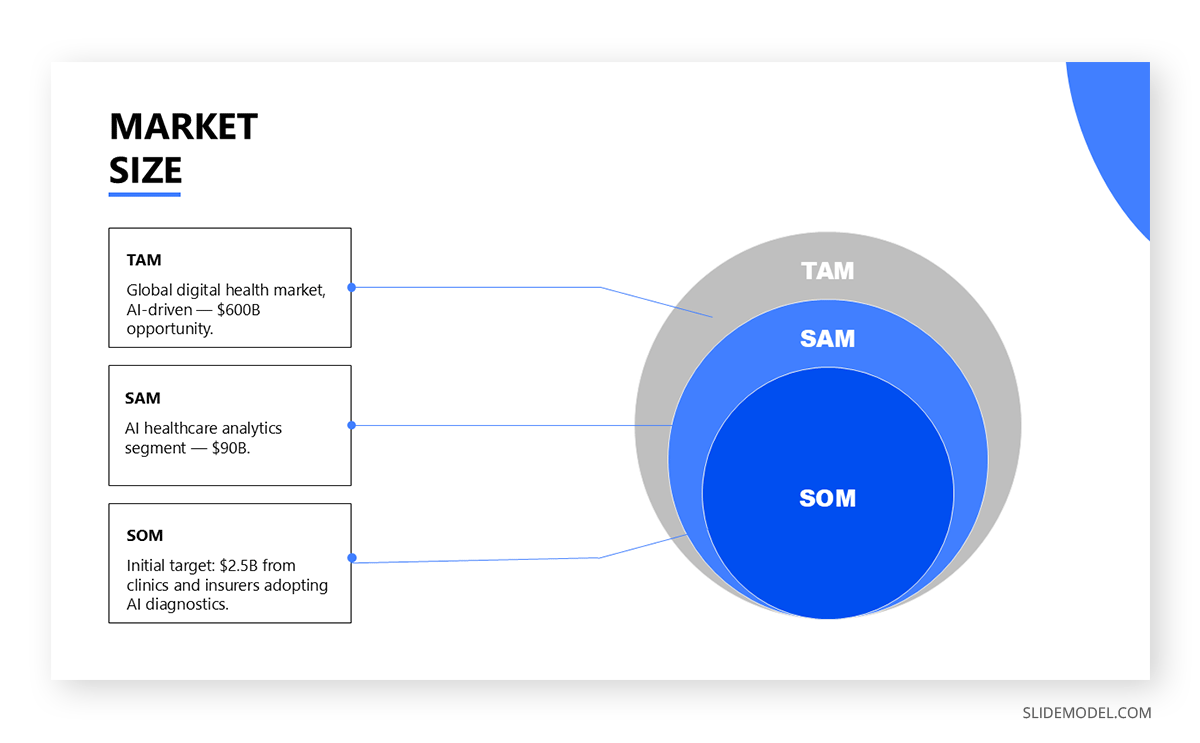
Next, describe how users currently attempt to solve the problem. Are they using outdated tools? Manual processes? Workarounds that consume time and money? Demonstrating that users already spend resources trying to fix the issue implies market willingness to pay for a better solution.
Incorporate empathy strategically. Use the problem’s human impact to make it tangible, but remain professional. A single quote, a short case, or a visual metaphor is often more potent than emotional storytelling.
What to Include in a Problem Slide
A complete problem slide balances clarity, evidence, and narrative focus. From a presentational standpoint, it should contain these core components:
- Problem Statement: A single, precise sentence summarizing the pain point. It should capture the core friction, not the consequences.
- Evidence or Data: A concise set of metrics proving that the issue is real and costly.
- Current Solutions or Gaps: A note on how the market currently copes with the issue and where those attempts fail.
- Visual Illustration: A chart, diagram, or infographic that captures the tension at a glance.
- Audience Impact: A brief depiction of who is affected and what the stakes are.
Avoid treating these as decorative bullet points; each must reinforce the others. The visual should not merely repeat the text; it should clarify relationships or magnitude.
PowerPoint Templates for the Problem Slide
Infographic and Diagram Templates
Use Infographic PowerPoint Templates to depict complex systems or behavioral flows. For instance, a circular process diagram can illustrate the recurring nature of a market inefficiency, while a broken-chain metaphor can show failure points in an ecosystem.
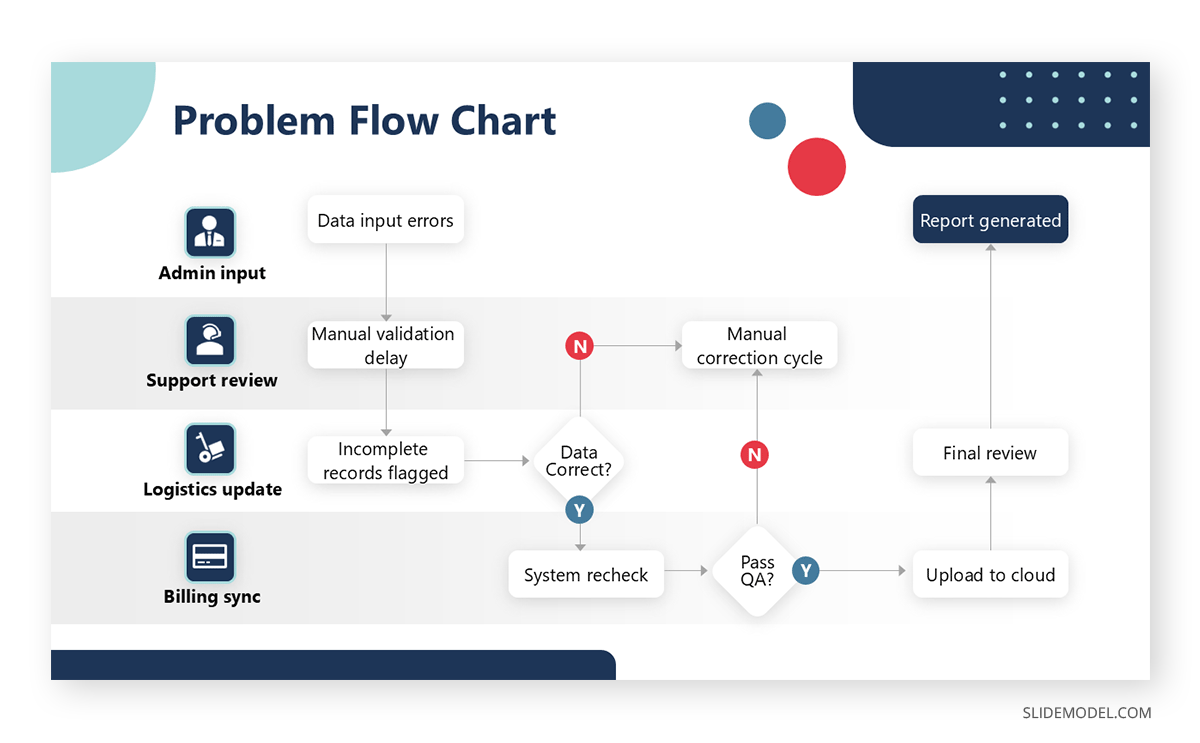
Comparison and Gap Analysis Templates
When emphasizing contrast between the “status quo” and the “improved state,” Comparison Slide Templates are ideal. They support minimal text, clear columns, and icons for visual guidance.
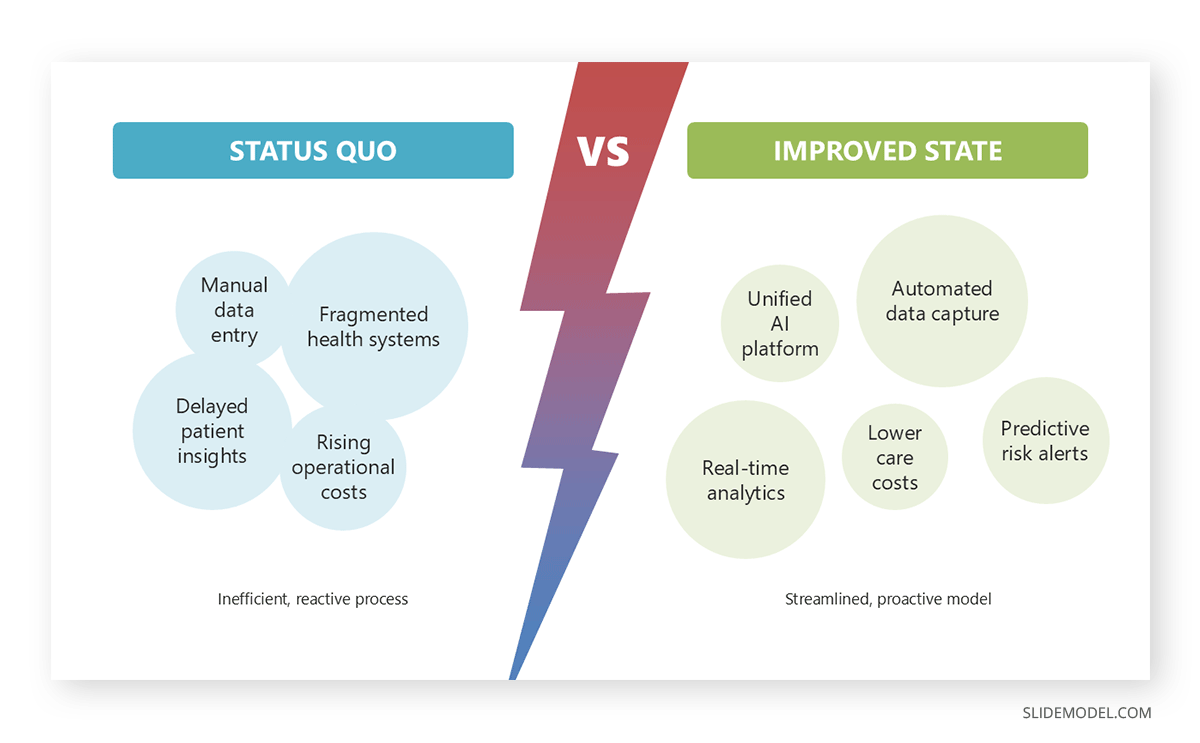
Gap Analysis Templates visually compare the current state of a problem with the desired outcome. In a problem slide, they clarify inefficiencies, highlight missing capabilities, and help investors instantly grasp where opportunities exist for measurable, solution-driven improvement.
Recommended lecture: Gap Analysis for Business Performance
Journey and Workflow Templates
If your problem is process-based, such as operational bottlenecks, consider using Process Diagram Templates. A linear flow helps the audience visualize exactly where inefficiency occurs.
Market Map or Data Visualization Templates
For region-specific or demographic issues, Map Templates and Data-Driven Charts effectively communicate spread and concentration. Always use neutral colors for context and one contrasting tone to highlight critical areas.
Mistakes to Avoid When Building the Problem Slide
Vagueness
Generalized claims like “the market is inefficient” or “customers are frustrated” lack evidentiary weight. Specify what kind of inefficiency and which customers. Investors need measurable definitions, not emotional appeals.
Oversized Scope
Framing a problem that affects “everyone” might sound ambitious, but it signals immaturity. Significant, undefined issues are perceived as unfocused. Narrow your definition to a solvable starting segment.
Missing Context
Avoid jumping straight into data without explaining causality. Numbers without storylines feel disconnected. Always explain why the problem exists before quantifying it.
Blaming Without Insight
Some founders turn the problem slide into a critique of competitors or industries. That approach alienates the audience. Instead, position yourself as an analyst uncovering a hidden inefficiency, not a crusader pointing fingers.
Overcrowded Slides
Like any other pitch slide, readability trumps quantity. Limit visuals to one or two strong graphics. Overloaded layouts dilute focus. If you have multiple data points, distribute them across supplementary slides for Q&A sessions.
Poor Design Contrast
If all data elements look visually identical, hierarchy disappears. Differentiate titles, figures, and explanations through typography size and restrained color contrasts.
Lack of Continuity
The problem slide must logically lead to your solution. If the next slide introduces a product that doesn’t directly address the issue presented, it breaks narrative flow. Investors immediately notice this misalignment.
SlideModel PowerPoint templates help mitigate most of these risks by providing balanced layouts and visual guidance. Adhering to a pre-structured format ensures your story remains consistent and professionally delivered.
FAQs
What is the primary goal of a problem slide in a pitch deck?
To define a clear, validated pain point that establishes the foundation for your solution. It converts your business idea from speculation to necessity.
Should I include multiple problems?
Preferably not. Focus on one core issue. Secondary problems can appear later as extensions or opportunities, but a single primary problem keeps your narrative focused.
What’s better in a problem slide: numbers or stories?
Both. Begin with a relatable scenario, then validate it with data. The story engages emotion; the data earns trust.
How much text should I include in a problem slide?
As little as possible. Investors don’t read long paragraphs on slides. Use brief statements supported by visuals. Detailed explanation belongs in your spoken narrative.
How often should I update my problem slide?
With every major market shift or funding round. A problem can evolve as new data emerges or as your solution gains adoption.
What if the problem changes after launch?
That’s normal. Be transparent in updates. Investors appreciate founders who adapt insights rather than cling to outdated assumptions.
Final Words
The problem slide defines the narrative lens of your entire pitch. It’s the diagnostic moment before the prescription. By articulating a clear, validated, and emotionally resonant problem, you demonstrate not just opportunity awareness but strategic depth.
For founders, this slide is a test of clarity and empathy. It reveals how well you understand your market and how disciplined you are in focusing on the real friction points. For investors, it’s the difference between another idea and a credible business case.

